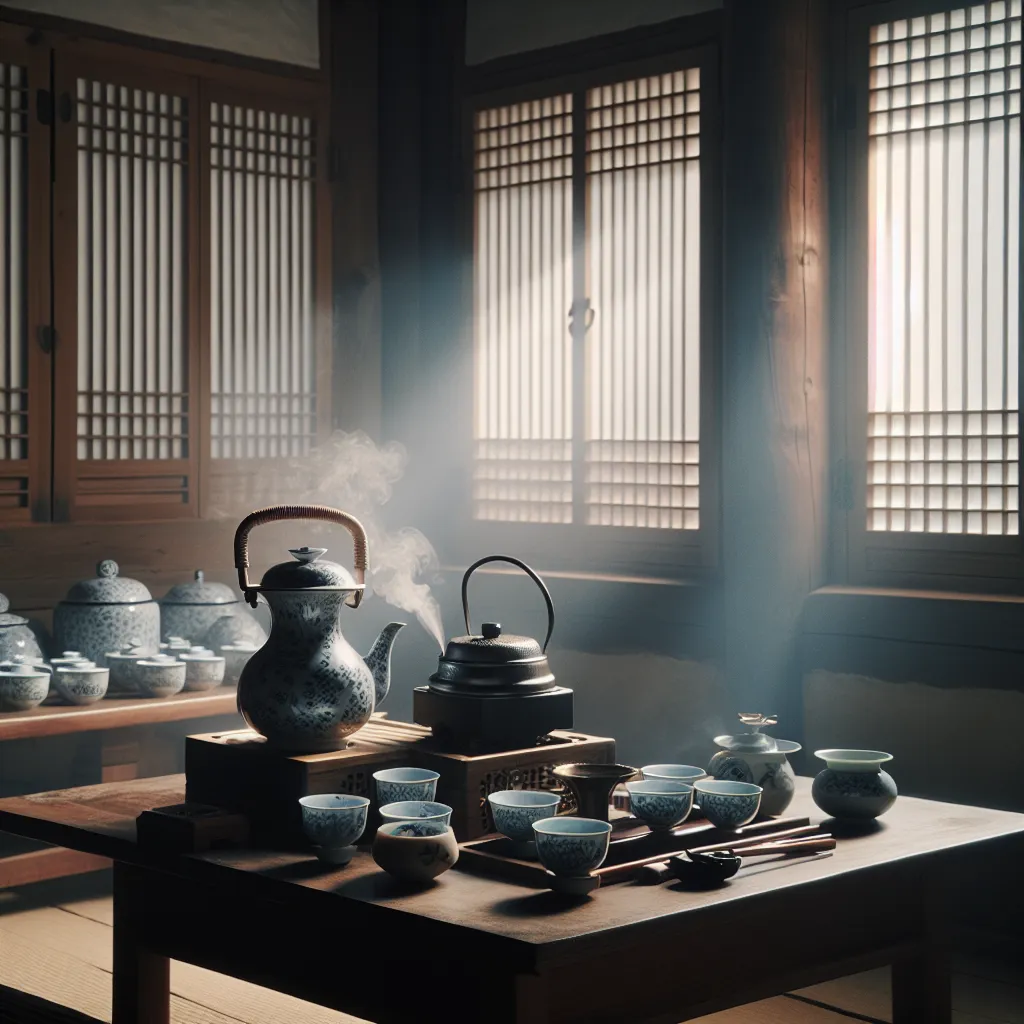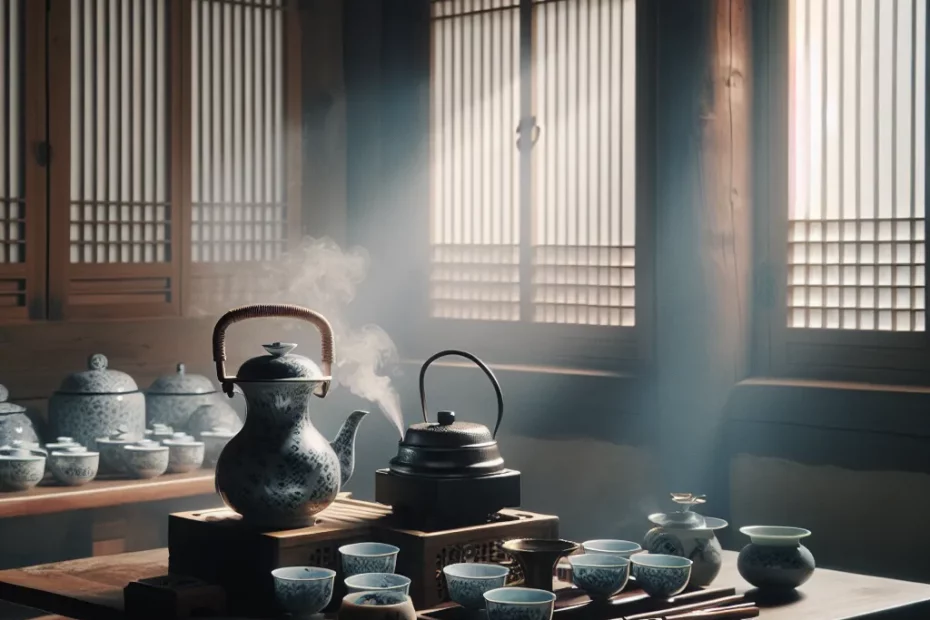Step into the world of Korean Tea Ceremony, where ancient traditions and serene rituals come together to create a harmonious experience. The art of tea preparation in Korea dates back centuries, steeped in cultural significance and mindfulness. As we delve into the origins of this time-honored practice, we uncover a rich tapestry of history and tradition that continues to resonate in modern times. Join me on a journey to explore the ceremonial tools and utensils used, each with its own symbolic meaning and purpose. Discover the intricate etiquette and rituals observed during the ceremony, guiding participants through a meditative and respectful process. Through this exploration, we will uncover the profound significance and the myriad benefits that the Korean Tea Ceremony offers to those who partake in its rituals. Embrace the tranquility and elegance of this ancient practice, and immerse yourself in a world of tea where every sip tells a story of tradition and mindfulness.

Origins of Korean Tea Ceremony
Welcome to a journey back in time to explore the rich origins of the Korean Tea Ceremony, a tradition deeply rooted in Korean culture and history. 🍵
The Goryeo Dynasty and Introduction of Tea
The Korean Tea Ceremony, known as “Darye” in Korean, dates back to the Goryeo Dynasty (918-1392) and was further refined during the Joseon Dynasty (1392-1910). This elegant ritual of preparing and serving tea holds a special place in Korean society, embodying principles of harmony, respect, purity, and tranquility. 🌿
During the Goryeo Dynasty, Buddhist monks played a significant role in introducing tea to Korea. Tea was initially valued for its medicinal properties and as a form of offering in Buddhist rituals. Over time, the practice of tea drinking evolved into a cultural art form, with an emphasis on mindfulness and spiritual connection. 🌸
The Joseon Dynasty and Flourishing of the Tea Ceremony
The Joseon Dynasty saw the Korean Tea Ceremony flourish even further, becoming an integral part of aristocratic gatherings and social interactions. The principles of Confucianism also influenced the tea ceremony, emphasizing etiquette, self-discipline, and the appreciation of simplicity. 🎎
In the Korean Tea Ceremony, every gesture, from the precise movements of preparing tea to the way it is presented and consumed, holds symbolic meaning. The host’s meticulous attention to detail and the guest’s appreciation for the tea reflect a harmonious relationship between the two parties. 🌟
Continuation of the Tradition
Today, the Korean Tea Ceremony continues to be practiced in traditional tea houses, cultural centers, and even in modern homes, keeping alive the essence of Korean heritage and hospitality. By participating in this serene ritual, one can experience a moment of peace and connection with both the past and the present. ☕
As we delve deeper into the intricate world of Korean tea culture, we uncover a treasure trove of history, tradition, and artistry that continues to captivate tea enthusiasts around the globe. Let us embrace the beauty and serenity of the Korean Tea Ceremony, honoring the centuries-old legacy it carries with grace and reverence. 🌺
In conclusion, the Korean Tea Ceremony stands as a testament to the enduring legacy of Korean traditions, inviting us to savor each sip of tea with mindfulness and appreciation for the cultural heritage it represents. 🌿✨
Ceremonial Tools and Utensils Used
In the traditional Korean tea ceremony, a variety of ceremonial tools and utensils are utilized to ensure the proper preparation and serving of tea. Each item has a specific purpose and plays a crucial role in the serene rituals of tea preparation. Let’s explore some of the essential tools and utensils used in this time-honored practice!
Tea Bowl (Dawan):
The tea bowl, known as “dawan,” is a central element in the Korean tea ceremony. It is carefully selected for its shape, size, and texture, reflecting the season and occasion. The bowl is where the tea is whisked and served, symbolizing harmony and respect.
Tea Whisk (Bamboo Chasen):
The bamboo tea whisk, or “chasen,” is used to mix the powdered green tea with hot water. The fine bristles of the whisk help create a frothy and smooth tea texture, enhancing the flavor and aroma of the tea.
Tea Scoop (Chashaku):
The tea scoop, or “chashaku,” is a bamboo utensil used to measure the perfect amount of powdered tea for each bowl. It symbolizes precision and attention to detail in the tea-making process.
Tea Caddy (Natsume):
The tea caddy, or “natsume,” is a small container used to store the powdered green tea. It is often made of lacquered wood and is carefully chosen to complement the other utensils used in the ceremony.
Water Kettle (Tetsubin):
The water kettle, or “tetsubin,” is a cast iron kettle used to heat the water for brewing the tea. Its design and material help maintain the ideal temperature for brewing, ensuring a perfect cup of tea every time.
Tea Cloth (Chakin):
The tea cloth, or “chakin,” is a small square of white cloth used to clean and purify the tea bowl and utensils between each serving. It represents purity and respect for the tea ceremony.
By using these ceremonial tools and utensils with care and reverence, participants in the Korean tea ceremony can fully immerse themselves in the tranquil and meditative experience of preparing and enjoying a cup of tea. Each item contributes to the beauty and authenticity of the ritual, creating a harmonious blend of tradition and mindfulness.
Etiquette and Rituals During the Ceremony
Welcome to the exquisite world of the Korean Tea Ceremony, where every movement and gesture holds profound meaning and significance. As you immerse yourself in this ancient tradition, it is essential to adhere to the strict etiquette and rituals that have been passed down through generations. Let us delve into the intricate details of the ceremony, where every step is a harmonious blend of grace and respect.
Entering the Tea Room
First and foremost, as you enter the tea room, remember to bow slightly as a sign of reverence and humility. This simple yet profound gesture sets the tone for the ceremony, emphasizing the importance of mindfulness and presence. The tranquility of the space is palpable, inviting you to leave behind the distractions of the outside world and fully engage in the ritual unfolding before you.
Observing the Tea Preparation
As the host begins the preparation of the tea, observe their movements with quiet admiration. Each action is deliberate and purposeful, from measuring the tea leaves to whisking the matcha to perfection. The rhythmic sound of the whisk against the bowl creates a soothing melody, further enhancing the serene atmosphere of the ceremony.
Serving and Drinking the Tea
During the serving of the tea, receive the cup with both hands as a sign of respect. Take a moment to appreciate the aroma wafting from the cup, savoring the anticipation of the first sip. When drinking the tea, do so in a series of three sips, each one symbolizing gratitude, respect, and purity. The flavor lingers on your palate, a reminder of the fleeting nature of each moment.
Mindfulness and Connection
Throughout the ceremony, maintain a sense of mindfulness and awareness, focusing on the present moment with unwavering attention. The act of sharing tea is not merely about the beverage itself but about fostering connections and building relationships. Engage in conversation with your fellow participants, sharing insights and reflections as you bond over this shared experience.
Expressing Gratitude
As the ceremony draws to a close, express your gratitude to the host for their hospitality and skill in conducting the ritual. A simple thank you and a bow convey your appreciation for the opportunity to partake in this sacred tradition. Take a moment to reflect on the experience, carrying with you the lessons of harmony, respect, and mindfulness that the Korean Tea Ceremony imparts.
In conclusion, the Korean Tea Ceremony is not just a ritual; it is a profound expression of culture, tradition, and spirituality. By observing the etiquette and rituals with reverence and grace, you honor the centuries-old practice and embody the spirit of tranquility and harmony. Embrace each moment of the ceremony with an open heart and a clear mind, allowing the transformative power of tea to envelop your senses and nourish your soul.
Significance and Benefits of Tea Ceremony
In the realm of traditional Korean culture, the Tea Ceremony stands as a venerable practice that embodies elegance, mindfulness, and harmony. Rooted in centuries-old customs, this ritualistic preparation and consumption of tea hold profound significance, offering a multitude of benefits beyond mere refreshment. 🍵✨
The Essence of the Korean Tea Ceremony
The essence of the Korean Tea Ceremony lies in its meticulous attention to detail, from the selection of tea leaves to the graceful movements of the host. Each gesture is imbued with symbolism, reflecting values of respect, tranquility, and connection with nature. Through this ceremonial process, participants are encouraged to cultivate a sense of mindfulness, focusing on the present moment and finding beauty in simplicity. 🌿🌸
Benefits of Engaging in the Tea Ceremony
One of the key benefits of engaging in the Tea Ceremony is the opportunity for social bonding and community building. As individuals come together to share in the ritual of tea preparation and consumption, bonds are strengthened, and relationships are deepened. The act of serving tea to guests is considered a gesture of hospitality and goodwill, fostering a sense of warmth and camaraderie among participants. ☕❤️
Furthermore, the consumption of tea itself offers a range of health benefits, making the Tea Ceremony not only a cultural practice but also a wellness ritual. Korean traditional teas are known for their antioxidant properties, which can help boost the immune system and promote overall well-being. Additionally, the act of sipping hot tea can have a calming effect on the mind and body, reducing stress and promoting relaxation. 🍵💆♂️
Embracing Simplicity and Connection
Beyond its social and health benefits, the Tea Ceremony serves as a reminder of the importance of slowing down and savoring the simple pleasures in life. In a fast-paced world filled with distractions, taking the time to engage in a ritual as timeless as the Tea Ceremony can be a grounding experience, allowing participants to reconnect with themselves and their surroundings. 🌟🍃
In conclusion, the Korean Tea Ceremony holds a special place in traditional culture, offering not only a moment of respite from the demands of daily life but also a profound opportunity for connection, mindfulness, and well-being. By partaking in this serene ritual, individuals can experience the beauty of simplicity, the warmth of community, and the nourishment of body and soul. 🍵🌺
Participating in the Korean Tea Ceremony offers a unique opportunity to immerse oneself in the rich cultural heritage of Korea. The intricate rituals, elegant tools, and serene atmosphere combine to create a truly unforgettable experience. By following the etiquette and procedures of the ceremony, participants can cultivate a sense of mindfulness and inner peace. The significance of the tea ceremony lies in its ability to foster connection, both with oneself and with others, while also promoting a sense of harmony with the natural world. The benefits of engaging in this ancient practice extend beyond the physical act of preparing and drinking tea, encompassing mental clarity, emotional well-being, and a deeper appreciation for the present moment. Embracing the Korean Tea Ceremony is not just a cultural experience, but a journey towards self-discovery and tranquility.
